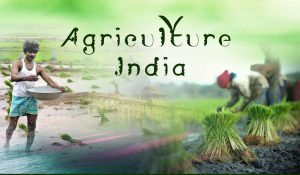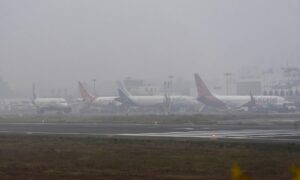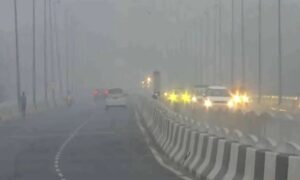
Image Courtesy: Ministry of Agriculture & Farmer’s Welfare, Government of India
By Amarnath Tripathi
While presenting Union Budget 2016–17, the Union Finance Minister Arun Jaitley mentioned that one of the objectives of the Government of India is to double the income of farmers by the year 2022. Income generation from agriculture is a critical issue as the major chunk of the population, about 60 per cent, engage in this sector for their livelihood. But, more important issue than realising the above fact that to understand how a doubling of farm income could be possible – what are the strategies. Diversifying cropping pattern towards fruits and vegetables away from staples (rice, wheat etc.) dominated cropping pattern is one of the promising strategies for achieving the above target.
Since food consumption behaviour shifted from cereals to high-value food items including fruits and vegetables, milk and milk products, and meat, egg, and fish, farmers could get a good return from the production of these products. Researches also show that small and marginal farmers can also draw income benefits from the cultivation of fruits and vegetables and livestock sector as well. But, the above sectors are facing a major challenge of post-harvest loss and transportation loss because of their perishable nature. The percentage of post-harvest losses as assessed by the ICAI – Central Institute of Post-harvest Engineering and Technology is about 6 to 16 per cent in the case of fruits and vegetables. The losses are about 5 per cent in fisheries (inland) sector while this figure is about 11 per cent in fisheries (marine) sector. Notwithstanding, non-horticulture crops also face a huge amount of post-harvest losses – 5 to 6 per cent in cereals, 6 to 8 per cent in pulses and 3 to 10 per cent in oilseeds.
A case study conducted in Azadpur mandi of Delhi by Dr Thiagu Ranganathan at the Institute of Economic Growth observed significant amount of wastage at trader level for selected agriculture commodities – Apple (11.08 % in winter and 15.38 per cent in summer), Potato (0.89 % in winter and 0.57 % in summer), onion (2.42 % in winter and 2.78 % in summer), tomato (1.86 % in winter and 1.12 % in summer), Banana (5.83 % in winter and 4.58 % in summer), Grapes (2.4 % in winter and 1.4 % in summer), Papaya (1.08 % in winter and 0.95 % in summer), and Green pea (0.90 % in winter and 0.80 % in summer). Considering these losses at trader level, one can imagine aggravated the situation of wastage at farmer level.
Cold Chain and Government Strategies
In order to arrest post-harvest losses of horticulture & non-horticulture produce, the establishment of National Spot Exchange Limited in December 2010, the cold storage capacity of about 61.13 million tonnes in the country is needed, while its existing capacity is about 23.5 million tonnes. Hence, a gap of about 37 million tonnes needs to be filled-up at the earliest. Lack of adequate infrastructure along with high cost of installation and operation is the major reason behind the above gap. The gap in cold storage capacity is likely to increase in future even if there is no change in its required capacity. It is mainly due to increasing demand for frozen food items led by changed life style.
Apart from it, national agriculture market, an agricultural marketing strategy adopted recently in the country, will increase requirement of the cold chain because of increasing transportation in this system. Under this initiatives, farmer or trader can sell his or her product in any market in the country beyond state boundary for a better price, which, in turn, leads to increasing the transportation of agricultural products.
The cold chain does not contribute to a reduction in post-harvest losses only, it helps farmers to overcome from the situation of price fall due to excess supply. There are many fruits and vegetables that are available seasonally and if there is an excess supply of any crop in a particular season, the price of that commodity will fall. But, we can prevent farmers from this adverse situation by providing efficient cold chain because farmers can store the excess amount of commodity in season and sell in another season. In this way, farmers can get better price of their products.
For last one decade, the MoFPI has been facilitating the establishment of a strong cold chain facility for agricultural, horticultural, dairy, fish & marine, poultry & meat products by establishing linkage from farm gate to the consumer, end to end, to reduce losses through efficient storage, transportation and minimal processing through financial assistance. An assistance of 50 per cent of the total cost of plan & machinery and technical civil works in general areas and 75% for North-east region and difficult areas (North Eastern states, Sikkim, Jammu & Kashmir, Himachal Pradesh and Uttarakhand) subject to a maximum grant-in- aid of Rs. 10 Crore per project is provided by the ministry.
In addition, Department of Agriculture, Cooperation and Farmers Welfare (Ministry of Agriculture and Farmers Welfare) and Agricultural and Processed Food Products Export Development Authority (APEDA) under Department of Commerce, Ministry of Commerce and Industries are also providing assistance for setting up cold storages under their respective schemes.
Various other incentives, such as exemption from service tax, a loan under priority sector lending, concession in customs duty, exemption from excise duty and recognising cold chain as infrastructure sector has been provided by the Government to promote the creation of a cold chain infrastructure in the country.
Despite the above initiatives, the situation of the cold chain in India is still unsatisfactory. There are three major bottlenecks in the growth of cold chain – lack of energy, poor connectivity and limited availability of land. Because of these reasons, the private sector is not getting the proper incentive.
There are many leading agriculture producing states such as Uttar Pradesh, Bihar, etc. where electricity is hardly available for 7 to 8 hours in a day. Similarly, many regions of the country like the north-eastern region are poorly connected with other regions of the country. Acquiring land and getting all government clearance is not very easy task, while the establishment of cold storage, one of a major element of cold chain system, totally depends on the availability of land and government clearance. Without fixing the above problems, one cannot expect significant improvement in India’s cold chain system and hence doubling farm income.

(The author is assistant professor, Institute of Economic Growth, Delhi University Enclave, Delhi. He can be contacted at amarnath@iegindia.org)


















